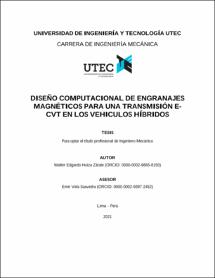Diseño computacional de engranajes magnéticos para una transmisión ECVT en los vehículos híbridos
Resumen
En la presente investigación se abordan los problemas de los engranajes planetarios en los vehículos híbridos, principalmente en la eficiencia; debido a que disminuye por el sonido, vibración, calor y diseño del perfil del diente. Por ello, el objetivo principal es diseñar de manera computacional engranajes magnéticos como una alternativa a los engranajes planetarios. Para realizar dicho propósito es necesario comprender el funcionamiento del sistema de transmisión continuamente variable de tipo electrónico (e-CVT por sus siglas en inglés) dado que, en su estructura, se utiliza dos engranajes planetarios cuya principal función es transmitir la potencia de los motores, tanto eléctricos como de combustión interna, hacia las ruedas. Se analizará y escogerá el motor principal del sistema de transmisión e-CVT con la finalidad de diseñar un engranaje magnético capaz de reemplazar y superar al engranaje planetario utilizado. Para ello, se analizará el torque magnético generado por los imanes permanentes; a fin de obtener un dimensionamiento que tenga la capacidad de transmitir la potencia necesaria para mover un vehículo híbrido modelo sedan. Asimismo, se analizará la eficiencia de los engranajes magnéticos como también la saturación magnética de los imanes permanentes. Como resultado, se propuso un engranaje magnético coaxial que tiene la capacidad de generar 249.75 Nm a una eficiencia del 98.7% y con un rango de saturación magnética de 0.5 – 4 T, llegando a superar a los engranajes planetarios en eficiencia y siendo viables para la instalación en el sistema de transmisión e-CVT. In the present investigation the problems of planetary gears in hybrid vehicles are addressed, mainly in efficiency; because it is diminished by sound, vibration, heat and the design of the tooth profile. Therefore, the main objective is to computationally design magnetic gears as an alternative to planetary gears. To achieve this purpose, it is necessary to understand the operation of the electronic-type continuously variable transmission system (e-CVT) since, in its structure, it uses two planetary gears whose main function is to transmit the power of the engines, both electrical and internal combustion, towards the wheels. The main motor of the e-CVT transmission system will be analyzed and chosen in order to design a magnetic gear capable of replacing and surpassing the planetary gear used. For this, the magnetic torque generated by the permanent magnets will be analyzed; in order to obtain a sizing that has the capacity to transmit the necessary power to move a hybrid vehicle model sedan. Likewise, the efficiency of magnetic gears as well as the magnetic saturation of permanent magnets will be analyzed. As a result, a coaxial magnetic gear was proposed that has the capacity to generate 249.75 Nm at an efficiency of 98.7% and with a magnetic saturation range of 0.5 - 4 T, surpassing planetary gears in efficiency and being viable for installation. in the e-CVT transmission system.
Citación
Huiza Zárate, W. E. (2021). Diseño computacional de engranajes magnéticos para una transmisión ECVT en los vehículos híbridos [Tesis de Título Profesional, Universidad de Ingeniería y Tecnología]. Repositorio Institucional UTEC. https://hdl.handle.net/20.500.12815/262Palabras clave
Colecciones
- Ingeniería Mecánica [73]


